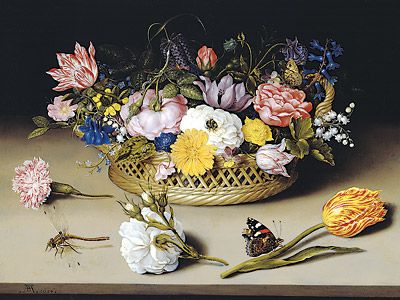It is enough to make one feel guilty!
Spending hours in the bright sunlight in the midst of winter, while practically everyone one knows is suffering extreme cold or torrential rains or both in rapid succession in Northern countries.
Winter in the Mediterranean has definite charms.
One of the most delightful of these charms is a part of the garden fragrant with a carpet of violets blooming. Every time I pick these lovely flowers, I remember the steep banks of Tanzanian mountain terraces bound with violets where I spent hours as a child picking huge perfumed bunches while my mother worked among the flowers in the terrace beds.
So it was natural that when I moved to Paris, I was delighted to find there were still ladies selling bunches of flowers on street corners and especially posies of Parma violets, the most fragrant of all violets, said to be from Toulouse.
And then I discovered the paintings and drawings of flowers that told of other people’s delight with violets down the ages as I spent hour upon hour in the French museums.
The love of violets showed up early, not surprisingly, in the wonderful margin illuminations in medieval manuscripts, where flowers are woven in with birds, insects and glorious arabesques and curliques. Since violets symbolize purity, modesty and pure love and are associated with the Virgin Mary, it was normal to include these spring flowers in Books of Hours and other religious works. Books of Hours were created from the 13th century onwards, often in France, and are still treasured works that remain jewel-like. Nonetheless, violets had come into the Christian lexicon from far earlier: the Greeks hadesteemed them and used them in sleeping draughts, health-giving tisanes, as sweetening for food, as well as loving their beauty. The Romans of course followed suit, and made wine from violets, used them in salads and as conserves. Violet tinctures and elixirs, perfumes and cosmetics helped restore health and well being. Later the Anglo Saxons believed in the curative powers of violets for wounds, and followed ancient practices of using violets to help restore the respiratory tract after colds and bronchitis. So it was not surprising that violets very so frequently illustrated in early holy books.
Individual early artists who celebrated violets, members of the Viola family, are Albrecht Dürer and Leonardo da Vinci.
Then came a long period when violets, and other flowers for that matter, were mostly painted by Dutch still life artists in the 16th and early 17th century.
It was really not surprising that the Dutch artists should celebrate flowers but they became masters of combining flowers, in one painting, that actually bloomed at entirely different times. Ambrosius Bosschaert the Elder (1583-1621) was one such master, painting on panels or on copper, works that glow.
A little earlier, French writer, traveller and artist, Jacques Le Moyne de Morgues had teamed up with the French Huguenots who unsuccessfully attempted to establish a colony in Florida in 1564, recording much of the flora and fauna he saw there. He also later worked in London and produced some beautiful botanical studies, considered the finest in the 16th century. He included violets in his repertoire.
The French heritage of botanical studies continued into the 18th and 19th century, as is demonstrated by Pierre Jean François Turpin, considered one of the best botanical and floral artists of the Napoleonic era and beyond, as well as another noted German botanical illustrator, Georg Dionysius Ehret. Another Frenchman who painted violets in a less rigourously botanical fashion was Paul de Longpre (1855-1911): he was very much into the Victorian era spirit of depicting flowers. Nonetheless, he know how to paint violets in a way that allows one almost to smell their perfume.
Wood Violet, Pierre Jean François Turpin, (1775-1840), (Image courtesy of Musee National d'Histoire Naturelle)
Indeed, the 19th century brought more attention to the humble violet, mainly as a prop in portraits of young ladies, as in Théodore Chasseriau’s and James Tissot’s cases.Edouard Manet obviously got enticed by bouquets of violets, for in the same year, 1872, he painted two pictures, on a study of a bunch of violets, the other a portrait of Berthe Morisot with a bunch of the same flowers.
The Victoria era brought a surge of interest to flower painting and the violet was one of the favoured flowers to paint, with its symbolism, fragrance and, I suspect, availability as Viola odorata varieties grow beautifully in well-watered, moderate to mild climates. The French and British artists seem to have been the most keen on painting violets, but in the United States, in the early 20th century. Lila Cabot Perry used violets in a couple of her paintings. Elbridge Ayer Burbank and Thomas Waterman Wood were other American artists who loved violets, as was the Tiffany artist, Alice Gouvy.
Today, artists still turn to the violet family in delight.
One only has to look on the Net at the many, many images, mostly photographs, of these lovely flowers. But perhaps, in anticipation of 14th February at the end of this week, this should be the last image about one of my most favourite flowers, one of them growing in a garden. One can just imagine their perfume scenting the air.
Happy Valentine’s Day, everyone!




































